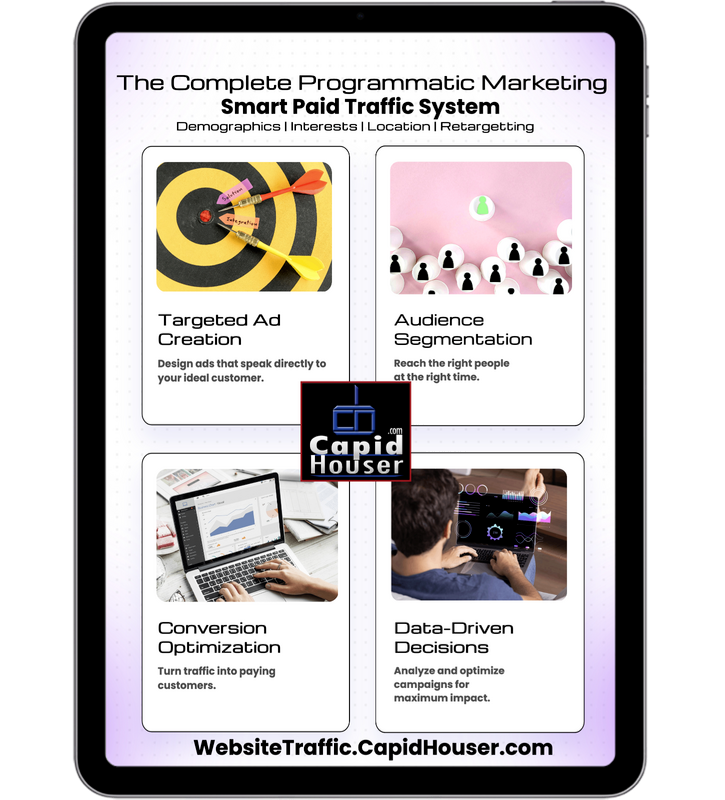Did you know that small businesses using programmatic marketing enjoy up to 2.5x higher conversion rates than those relying on traditional ads? Programmatic marketing has quickly transformed the digital advertising landscape, enabling small business owners to compete head-to-head with larger brands by using advanced targeting and automated ad buying technology. If you’re ready to unleash rapid growth, minimise wasted ad spend , and finally reach your ideal customer , this guide reveals everything you need to know — from top tools to real-world success stories.
Marketing for Small Businesses: Key Concepts and Current Trends
The digital ad world can be overwhelming for small business owners, but programmatic marketing for small businesses changes the game. Programmatic advertising uses automated, data-driven technology to buy and place ads in real-time, targeting your perfect audience segment and offering unmatched efficiency. Recent trends show even small and medium enterprises now dominate mobile ads, video ads and even audio ads by leveraging programmatic ad platforms — going far beyond traditional ad tactics.
Where once digital advertising meant endless guesswork about ad format, audience targeting, and campaign goals, programmatic marketing ushers in an age of smart, results-driven campaigns. With real-time bidding, dynamic creative options, and access to premium ad space across networks, small businesses can make every advertising pound count and put their brand in front of the right audience with laser precision. Harnessing programmatic technology enables you to keep up as the digital marketing landscape shifts, drive real growth, and maximise ROI.
What is Programmatic Advertising and How Does It Benefit Small Businesses?
At its core, programmatic advertising refers to the automated buying and selling of digital ad inventory through advanced algorithms. For small businesses, this means no longer competing with deep-pocketed brands for every ad placement. Programmatic marketing helps you identify your target audience using data points like behaviour, demographics, and even browsing context, ensuring your messages appear to potential customers at ideal moments.
Benefits for small businesses include scalable reach, measurable results, and budget efficiency. Rather than manually negotiating ad placements with publishers, a programmatic platform selects the best spaces and formats for you, from display to video ads. In a market where every dollar invested must deliver, programmatic advertising invites agility — shifting your ad spend to the highest-performing audiences, controlling costs, and building stronger brand awareness for your small and medium enterprise.

Cutting Through the Noise: Why Small Businesses Can’t Ignore Programmatic Ad Platforms
With digital advertising channels more crowded than ever, it’s easy for small business messages to get lost. Programmatic ad platforms level the playing field, allowing small businesses to harness advanced targeting and data analytics just like the world’s biggest brands. Instead of competing for generic audiences, your budgets are funnelled directly to people most likely to buy or engage, thanks to behavioural, contextual, and geolocation targeting.
By embracing programmatic ad solutions, small businesses can cut through the noise and ensure high brand awareness where it matters most. Whether your goal is to boost leads, launch video ads that captivate your target audience, or refine campaign goals, the flexibility of programmatic advertising makes it an indispensable tool for modern growth. Don’t let outdated approaches hold you back — the modern programmatic platform offers unprecedented control and impact for businesses of any size.
Essential Elements of Programmatic Marketing for Small Businesses
Audience Targeting and Advanced Strategies in Programmatic Advertising
Advanced audience targeting sits at the heart of any effective programmatic advertising strategy. These automated systems allow small businesses to pinpoint the people who matter most, segmenting potential customers based on their interests, behaviour, and online journeys. Using a mix of technology and data, you can combine several targeting strategies to ensure your digital advertising efforts reach the right audience at precisely the right time.
Demographic targeting
Behavioural targeting
Geo-targeting
Contextual targeting
By layering these audience targeting options, your programmatic campaign can focus spending on the segments most likely to convert, delivering maximised results for minimum waste. Whether you are advertising offers for a brick-and-mortar location or expanding online lead funnels, advanced targeting is the edge small businesses need to thrive.
Crafting Effective Ad Creative for Small Business Success
No matter how sophisticated your targeting or programmatic ad platform, success depends on your ad creative. These are the images, copy, and interactive elements that capture your audience’s attention and drive them to take action. For small businesses, quality ad creative means cutting through digital clutter and making your unique offer stand out—whether via video ads, display banners, or creative audio ads.
“For every £1 invested in well-targeted programmatic ads, small businesses can see up to £3 in revenue growth.” – Digital Ad Industry Insight
To succeed, tailor your ad creative formats to match your goals (awareness, conversions, website traffic, etc.) and test different versions to discover what resonates most with your audience segment. High-quality visuals, clear calls to action, and concise messaging create a powerful connection with potential customers, maximising the impact of every digital ad.

Setting Campaign Goals that Drive Real Results
Before launching any programmatic advertising, a small business should set specific, measurable campaign goals . Are you seeking more online leads, increased in-store visits, or stronger brand awareness? Your campaign goal should dictate the ad format, creative approach, and targeting strategy. Clear objectives also enable you to track progress, optimise campaigns, and justify your digital ad spend with hard data.
Set SMART campaign goals: Specific, Measurable, Achievable, Relevant, and Time-bound. Monitor metrics such as conversion rate, CPA, and click-through rate to ensure advertising efforts stay on track. Programmatic platforms provide granular analytics that small businesses can use to refine tactics in real-time, ensuring every campaign delivers maximum value.
Step-by-Step Guide: Launching Your First Programmatic Marketing Campaign for Small Businesses
Assess your target audience: Who is your ideal customer? Develop audience segments using demographic and behavioural data.
Choose a reputable programmatic platform: Select a partner with strong targeting, integrations, and support tailored to small businesses.
Allocate digital advertising budget smartly: Determine how much you can invest and set campaign goals based on ROI expectations.
Develop high-impact ad creative: Produce engaging visuals and messages aligned with your brand and objectives.
Set specific and actionable campaign goals: Define what success looks like using clear KPIs like conversion rate or increased sales.
Launch, monitor, and optimise: Deploy your campaign and adjust based on real-time analytics to maximise results.
This step-by-step process ensures every pound spent on programmatic advertising is purposeful, data-driven, and primed for growth. It also ensures that your team’s time and creativity are focused on where they’ll have the greatest effect.
Programmatic Ad Platforms for Small Businesses: Top Tools Compared
Platform |
Ease of Use |
Cost |
Targeting Options |
Support |
Integration |
|---|---|---|---|---|---|
Google Display & Video 360 |
High |
Medium |
Extensive |
Comprehensive help centre + community |
Excellent with Google stack |
The Trade Desk |
Moderate |
Medium |
Comprehensive |
Dedicated account management |
Wide third-party integrations |
Xandr |
Moderate |
Medium |
Advanced targeting |
Responsive client support |
Great with enterprise tools |
AdRoll |
Very High |
Low-Medium |
Focused (SMB-centric) |
Strong onboarding & tutorials |
Easy with Shopify, WooCommerce, and more |

Best Programmatic Advertising Options for Small and Medium Businesses
Google Display & Video 360
The Trade Desk
Xandr
AdRoll
Each platform has unique benefits for small businesses. Google Display & Video 360 integrates seamlessly with Google Analytics, while The Trade Desk offers robust cross-channel targeting. AdRoll is especially popular for smaller teams due to its friendly interface and strong SMB support . Choosing the right programmatic platform is crucial for maximising ad spend and scaling your growth.
Budgeting for Programmatic Marketing: Making the Most of Every Pound
Minimum Budget for Programmatic Advertising and Cost Expectations
One common myth is that programmatic marketing for small businesses demands a huge budget. In reality, entry-level programmatic platforms allow small business owners to get started from as little as £200-£500 per month, making it easy to test, learn, and grow. Budget requirements often depend on your target audience size, campaign goals, and selected ad formats (e.g., video ads or display ads).
Advanced targeting can make sure every pound works harder by narrowing the reach to only your ideal customer, which reduces wasted ad spend . Monitor cost-per-acquisition (CPA), conversion rates, and overall ROI for each campaign to ensure your digital advertising achieves its financial targets—adjusting spend to push your best-performing ad creative and placements.

Optimising and Measuring Your Small Business Programmatic Campaigns
Key Metrics and Analytics in Programmatic Advertising
Impressions
Click-through rate
Conversion rate
Cost per acquisition (CPA)
To ensure programmatic advertising delivers for your small business, focus on key performance metrics. High impressions indicate your ad receives significant exposure, but what matters next is whether it’s drawing clicks and conversions. Monitor your click-through rate (CTR) and conversion rate to identify winning audience segments and effective ad creative. Calculating CPA helps compare campaign costs against real results, guiding smart budget allocations for each campaign goal.
Continuous Improvement: A/B Testing and Dynamic Creative Optimisation
Ongoing optimisation separates good campaigns from great ones. With A/B testing, you compare two versions of an ad creative, headline, or ad format side-by-side, learning which resonates best with your audience. Dynamic creative optimisation can even automate different combinations, presenting your ideal customer with messages most likely to convert.
Frequent testing and adjustments ensure your digital advertising strategy adapts quickly to shifts in consumer behaviour and changing market trends. Track, learn, and iterate—taking advantage of programmatic platform analytics to drive better campaign performance and maximise every digital advertising pound.

Overcoming Common Challenges in Programmatic Marketing for Small Businesses
Avoiding Wasted Spend in Digital Advertising Campaigns
Wasted ad spend remains a key concern for many small business marketers. Poor targeting, unclear campaign goals , or under-optimised placements can drive up costs without delivering meaningful results. The antidote is to regularly review campaign analytics and make changes where needed—eliminating low-performing audiences, refreshing stale ad creative, and shifting budget towards top-performing segments.
Leverage the power of programmatic ad platforms to automate negative targeting (excluding people unlikely to convert), cap ad frequency to prevent audience fatigue, and continually monitor your right audience metrics. With diligent oversight, programmatic advertising helps small businesses minimise waste and stretch every advertising pound further.
Real-World Examples: Small Businesses Winning with Programmatic Advertising
‘Programmatic marketing enabled our small business to increase leads by 80% in just six months.’ – UK SME Success Story
Case study: Local retailer increases in-store traffic — By focusing on geo-targeting, a London retailer used programmatic advertising to get local shoppers in the door during sales events, doubling its weekend traffic compared to traditional ads.
Case study: B2B consultancy boosts online lead generation — A small business consultancy applied advanced audience targeting and A/B testing to their programmatic ad campaigns, resulting in a 50% reduction in cost per acquisition and a surge in qualified enquiries.
Case study: Hospitality provider maximises last-minute bookings — A boutique hotel chain used real-time data to show dynamic display ads to travellers searching for last-minute accommodation, driving up occupancy rates and increasing revenue per stay.
Each example demonstrates how programmatic strategies, strong ad creative, and clear campaign goals can fuel rapid growth for UK small businesses.
People Also Ask: Key Programmatic Marketing Questions for Small Businesses
What are the 4 types of programmatic deals?
The four main types of programmatic deals are:
Open Auction (Open Exchange): Ads are bought and sold in real time for the highest bidder on an open marketplace.
Private Marketplace (PMP): Invite-only auctions where select advertisers can bid for premium ad space.
Preferred Deals: Direct deals between publishers and buyers for reserved inventory at fixed prices before any auctions.
Programmatic Guaranteed: Fixed deals where both sides agree in advance to buy a set amount of ad inventory at an agreed rate.
What is the minimum budget for programmatic advertising?
Most entry-level programmatic campaigns for small businesses begin at around £200–£500 per month. This allows you to test different audience targeting approaches and ad creatives before scaling spend according to performance. More advanced platforms or competitive sectors may require higher budgets for greater reach and data sophistication.
Is digital marketing worth it for small businesses?
Absolutely. Digital marketing, especially programmatic advertising, gives small businesses direct access to highly targeted audiences and actionable analytics, often at a more affordable cost than traditional ad channels. Programmatic campaigns help you reach more potential customers efficiently, measure every dollar spent, and grow your brand in today’s digital-first marketplace.
What is the most effective form of advertising for a small business?
The most effective advertising for a small business often combines targeted programmatic ads with high-quality creative and clear campaign goals. Video ads, responsive display formats, and localised targeting typically see the best results — particularly when combined with continuous optimisation and precise audience segments.
FAQs: Programmatic Marketing for Small Businesses
Can programmatic ad platforms work for brick-and-mortar stores?
Yes, advanced geo-targeting in programmatic ad platforms helps brick-and-mortar stores drive real-world foot traffic by delivering digital ads to nearby potential customers.How do local businesses benefit from programmatic advertising?
Local businesses gain by reaching specific geographic areas and interest groups, effectively increasing in-store visits or local online purchases through targeted digital ad campaigns.What’s the biggest mistake small businesses make with programmatic ads?
The biggest mistake is neglecting to define precise campaign goals or failing to regularly review and optimise performance metrics, leading to wasted ad spend and missed growth opportunities.Do I need a marketing agency to run programmatic campaigns?
Many platforms are designed for self-service and ease of use, but a marketing agency or consultant can accelerate learning and deliver faster results, especially for advanced strategies or larger budgets.How quickly can I see results from programmatic marketing?
Many small businesses start to see results within days or weeks once campaigns are launched and optimised, though the best performance improvements often come after ongoing refinement and A/B testing.
Key Insights: Actionable Takeaways for Small Business Success with Programmatic Marketing
Leverage programmatic marketing for data-driven, targeted reach
Start small, scale as you optimise
Craft clear, realistic campaign goals
Regularly review and improve campaign performance
Choose the programmatic platform suited to small business needs
Ready to Get Started? Expert Programmatic Marketing for Small Businesses
Take your digital advertising to the next level and supercharge your business growth by choosing the right programmatic marketing strategy . Contact us at https://www.capidhouser.com/paid-website-traffic/ to discuss your Display Ads Marketing Strategy .
Programmatic marketing offers small businesses a powerful tool to enhance their advertising efforts through automation and data-driven strategies. For a comprehensive understanding of how programmatic advertising can benefit small and medium businesses, consider reading “ The Benefits of Programmatic Advertising for Small and Medium Businesses (SMBs) .” This resource delves into key advantages such as precision targeting, cost efficiency, and real-time performance tracking, providing actionable insights for SMBs looking to optimize their marketing strategies.
Additionally, “ The Game Changing Benefits of Programmatic Advertising for Small Businesses ” explores how programmatic advertising enables small businesses to compete effectively by leveraging advanced targeting and real-time optimization. This article highlights the transformative impact of programmatic strategies on small business growth and customer engagement.
If you’re serious about leveraging programmatic marketing to boost your small business’s growth, these resources will provide you with the knowledge and strategies needed to implement effective and efficient advertising campaigns.
 Add Row
Add Row  Add
Add 




Write A Comment